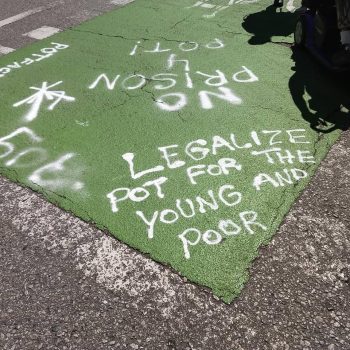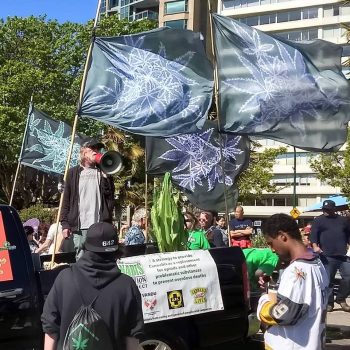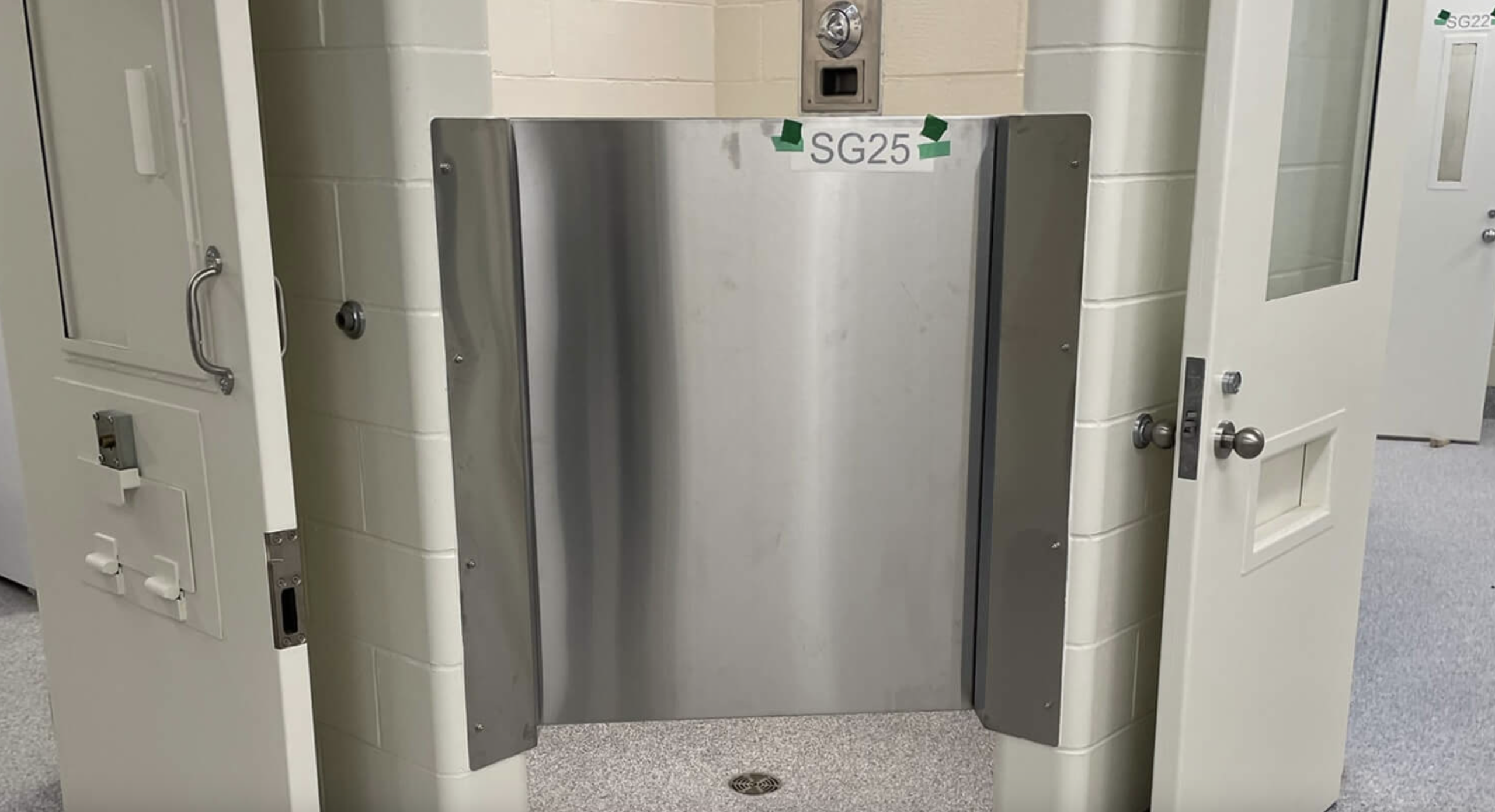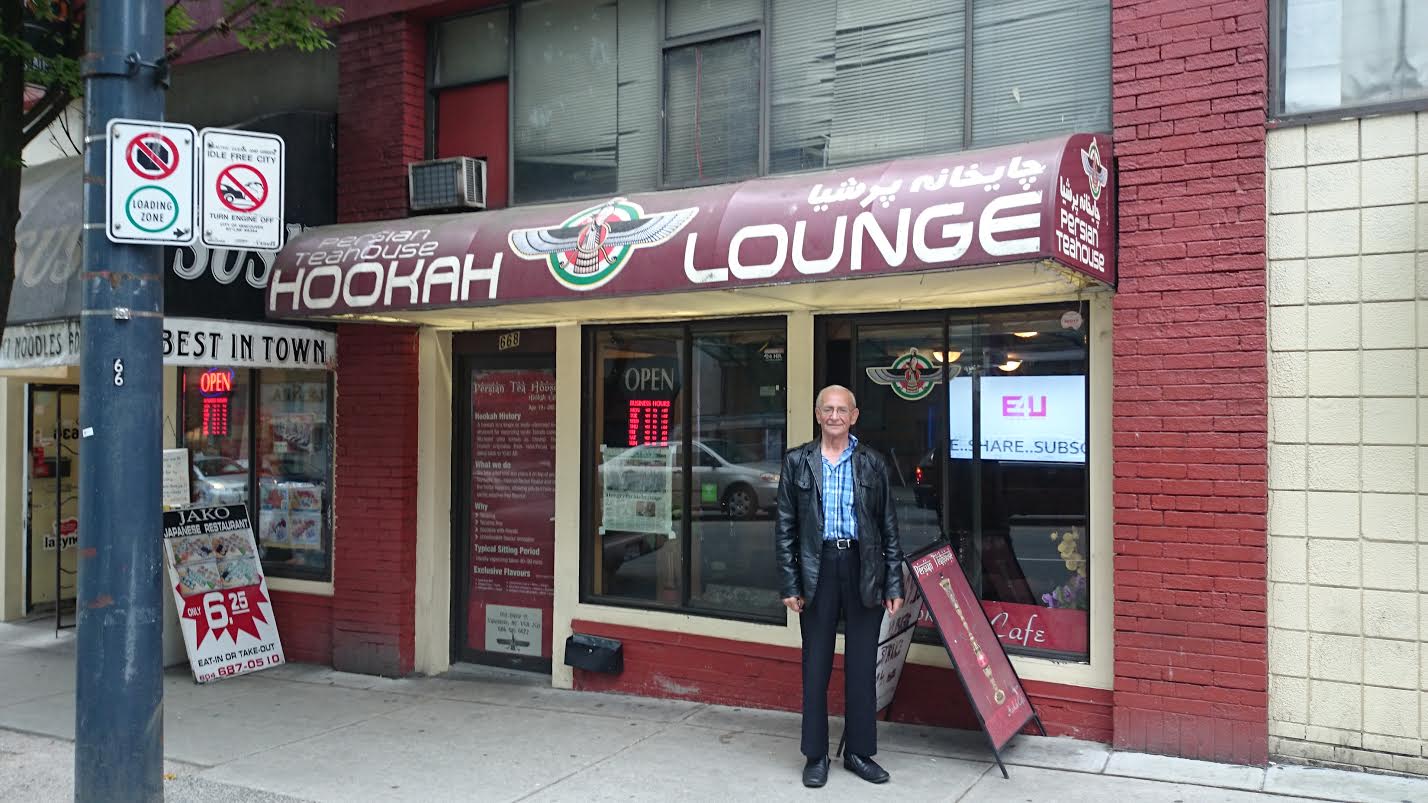Post-Legalization Pot Activism: Adjustments in Goals and Tactics

CANNABIS CULTURE –
“If we don’t take action now
We’ll settle for nothing later
We settle for nothing now
And we’ll settle for nothing later.”
– Rage Against The Machine, Settle For Nothing
“Bring down the government
They don’t, they don’t speak for us”
“I’d like to say that people can change anything they want to; and that means everything in the world.”
– Joe Strummer: The Future Is Unwritten (2007 documentary)
 New Tactics for the GMM
New Tactics for the GMM
It was a beautiful sunny Saturday, May 5th, 2018. The Global Marijuana March was to begin in about an hour, and I was assembling the signs I had made for the occasion. A group of about 50 activists had gathered at the art gallery. Some tended to their float vehicles, others made speeches. A pot dealer sat in the middle of the crowd with a table and some jars and a scale. It looked like another nice friendly hassle-free march (what we usually but not always experienced) … and then the fascistic encroachment began.
It started with a bunch of cops pulling up to the Vancouver Global Marijuana March in squad cars and a paddy wagon. When the paddy wagon pulls up – even in tolerant Vancouver (or “Vansterdam” as we jokingly or wishfully call it) it means the man means business.
Interestingly, this time they didn’t go for an arrest.
We had explained to them repeatedly (most recently back in 2015) that any arrest of a non-violent protester would not go over well with the crowd.
On that day we non-violently resisted the arrest of one dealer (it usually results in either the cops backing off or looking bad in front of cameras – see my discussion of Hug Power here.) and there was a big scuffle. Four people including myself were arrested. The obstruction charges were dropped after we went to court to a few appearances.
This time – instead of arresting anyone – they went for confiscation of the pot dealer’s business. It appears the police were doing two things with this confiscation:
1) to wear us out and dampen our enthusiasm by picking off the small businesses one by one
2) seeing if we would risk arrest for property – or over-react. Their job was to destroy us either with goading us into aggression or bullying us into submission.
We let it all happen without grabbing the gear or interfering with the confiscation, but it got me thinking. Maybe we should have done something more. Not touch the cops. Not touch the product. I was thinking more like everyone who could get arrested that day surround the dealer, link arms and start singing “A Dealer Is A Person In Your Neighborhood” to the tune of Sesame Street’s “Who Are The People In Your Neighborhood” – everyone who couldn’t get busted would record the event with phones from multiple angles.
This would result in two things happening: we would
1) be demonstrating solidarity with the dealer, while at the same time
2) demonstrating non-violent resistance to police fuckery. I think those are the right messages to send out to the young people.
Which brings me to the topic of this article.
Now that pot is about to become “legal” (for old people to smoke it and rich people to grow and deal it, anyway), what changes for pot activists? What are the principles that guide us? What should our new end goals be? And what adjustments to tactics – such as the one mentioned above – be used in fighting for those goals?

Principles
A good legalization model is one where the harmless are protected from harm. I tried to explain this to the Supreme Court of Canada back in 2003 but they were too busy pretending to be convinced by my arguments in person while greasily concocting lame excuses for continued prohibition – equating pot users with cannibals – to be included in their decision later on. I still think the harm principle is the relevant principle to shape drug policy with, regardless of the Supreme Court’s betrayal of humanity in R. v Malmo-Levine.
Goals
What this goal – the harmless shall not be harmed – ends up becoming when transformed into cannabis policy is where nobody is punished anymore for any non-harmful-to-others activity and nobody is punished even if they harm themselves. In the event of self-harm, we as a society should try to reduce self-harm with education and no longer attempt to use the police.
Practically speaking, the fair-trade organic coffee bean regulations – where there are no barriers to participation in the growing, buying, selling, importing and exporting and using of coffee beans other than those which apply to organic cultivation standards and fair trade labor standards – should be the same ones we use to regulate cannabis. These regulations are harm-focused and prevent harm to others so they are justified.
The current set of regulations proposed by Canadian federal and provincial governments – Bill C-45 – which attempts to regulate cannabis like a hard drug (more strictly than even alcohol and tobacco – the two hardest drugs) are more focused on creating artificial stigma and exclusivity and actually cause all kinds of prohibition-related harms, including unnecessary punishment to harmless people.
To sum it up, the powers-that-be are trying to shove hard-drug regulations down our throat. We activists must promote soft drug regulations to prevent the harms that come with prohibition – the most dangerous types of harms that drugs can be associated with.
We must no longer be simply “legalization” activists. We must adjust to become “inclusive legalization” activists. My argument is that those activists that don’t fight for the inclusion of the young and the poor in legalization are simply opportunists in disguise.
When cannabis is treated like coffee beans, there will no longer be any more targets for the police on the pot-war battlefield. A side effect of this is that we will also be able to remove all the red tape around industrial hemp, make hemp ethanol more competitive against gasoline and help save the world.

Tactics
Aside from surrounding the dealer at the next pot rally and singing a song of dealer de-stigmatization that even police are smart enough to understand, what other tactical adjustments are required to meet our new soft-drug-regulation goals?
I do believe that the tactics we have used so far – court challenges, election campaign participation, educational projects, art projects – activities that increase awareness and reduce stigma – are still the way to go. We dragged the powers that be and their minions in straight society kicking and screaming over to legalization – we need to drag them a bit further to inclusive legalization.
But the goals that we now are focused on – soft drug regulations – need facts that support those goals easily available and organized intuitively to be engaging. This is the reason I created the website pot-facts.ca – a great weapon for the pot peace activist of today. In it you will find all kinds of facts in support of that goal of soft drug regs. Primarily, we activists need to dispel the myth that cannabis smoking makes teens stupid and crazy, and to a lesser extent the myth that cannabis smoking in inherently impairing and will lead to an increase in traffic accidents.
If we as pot activists don’t dispel these myths, we will not be successful in achieving our goals. Stay on topic – myth debunking – and we will win.
We should view it as a game: if you can get these arguments on TV, the radio or the newspapers, you get one point in your column. If you miss the opportunity or if the prohibitionists get to spread those lies unchallenged, they get a point in their column. The stakes are high – the enslavement of human-kind and the destruction of the environment could very well be the price of failure. But success is very achievable.
It’s as simple as making this argument:
“The general population stats prove that cannabis use rates have gone up but psychosis rates have stayed the same and I.Q. rates have also gone up – this disproves the “cannabis harms developing minds” myth – cannabis should be regulated like coffee beans, not plutonium.”
Or this:
“Cannabis related fatality stats have gone up because they now routinely test for THC in the bloodstream of accident victims whereas before legalization they didn’t. The fact is where cannabis smoking is permitted alcohol drinking is reduced – fatal drunk driving is reduced by an average of ten percent in US states that have legalized. And cannabis impairment is much less than impairment from legal levels of alcohol.”
If you don’t have time to say all that, just saying (or writing) “pot-facts.ca” is a way to sum it all up in a nutshell.
New Media
One neat idea that fellow activist Carley Marley pointed out to me at the Global Marijuana March is that chalk now comes in a spray can and is available cheap at retail stores and online.
This spray chalk is perfect for getting your message out on the march when you don’t have a lot of time to write. Because it’s chalk, the cops tend to ignore it – nobody can claim you are damaging anything with it. I took the opportunity to write “pot-facts.ca” and “pot is not a hard drug” and “legalize pot for the young and poor” along the parade route. I recommend people do this wherever they can, as often as possible. Stickers, posters, sculpture, painting, murals, various types of art installations, bus advertisements and anything else that can carry our “pot is a soft drug” message should be used right now. Because under the current proposed system, the powers that be want to shut down as many small businesses as possible. It’s our job to make them prove it’s a hard drug to justify their hard drug regs – and they have been unable to do so.
But the spray chalk is only one medium. We need to use all mediums. Court challenges. Phone-in shows. Street performance. Sky-writing. You name it.
The question they don’t have an answer for
I attended a CBC panel discussion on cannabis and teens called “4:19” which took place on April 19th – a day before 4/20.
Assembled were all the experts CBC could round up to defend both the new proposed laws and the notion that cannabis harmed the developing mind. I of course asked the following question:
“Why won’t you address the general population statistics or provide a realistic cost-benefit analysis of cannabis use – and I’ll explain what I mean by that. The general population statistics indicate that psychosis remains steady – at one or two percent – in western societies, and I.Q.s go up every year – it’s called the Flynn Effect – but cannabis use rates have skyrocketed since the 1960s. If it actually made our kids stupid or crazy, you’d see I.Q. rates go down and psychosis rates go up – but we don’t see that. And when I talk about a cost-benefit analysis, I’m talking about: ‘Do you actually care what teens are dying from?’ Because it’s not pot – it’s nothing to do with pot. Teens are dying from suicides, car crashes, and alcohol and opioid overdoses. And cannabis – if it was like the Senate recommended in 2002 – if teens had access to safe places to smoke we could reduce those deaths. Why won’t you address that?”
My question is at – 19:04 – towards the end of the video, with 19 minutes remaining in the event.
You can then see their experts try and focus on one aspect of what I said – that pot use rates have skyrocketed since the 1960s – they focus on the fact that use rates decreased a bit after the 1990s – but ignore the fact that use rates went up from the 1960s to the 1990s and they don’t talk about I.Q rates or psychosis rates at all.
This point was thankfully not lost on other reporters covering this event:
Zach Walsh, another UBC researcher specializing in cannabis, concurs. “The evidence is weaker than the rhetoric.” According to Walsh, there appears to be a link between schizophrenia and other psychosis and marijuana use, but this could just be an association rather than causal. He notes that there’s been a dramatic increase in cannabis use in recent years, especially in Canada, but schizophrenia levels have stayed stagnant.
Why couldn’t the CBC have gotten that guy on their panel?
You can see this is going to be the argument that will win or lose inclusive legalization for us. It’s the main myth of the modern day period – and has been since the “Assassin of Youth” “Reefer Madness” days of the 1930s.
Each and every time I challenge prohibitionists with this information, they don’t have an answer. The pharmacology professors don’t have a good answer.
And neither do the professional prohibitionists.

Image from: Last Dance with Mary Jane ft. Tom Petty & Jelly Roll (Official Music Video)
I invite all pot activists to familiarize themselves with these facts and use every opportunity to get them on TV. Pot doesn’t make kids stupid or crazy. It doesn’t make you a bad driver. It isn’t a hard drug. We need soft drug regulations – organic, fair trade coffee bean regulations – we need to end the entire pot war, not just the war on rich growers and dealers and old users, but end the war for all pot criminals regardless of which harmless activities they participate in.
If we keep hammering this point home, it will be a goal we achieve. If we settle for less, we will get less – but reason, and duty, demand more of us. Farmers, gardeners, dealers and young users all around the world are counting on us. We should all do our best not to let them down. We will get for what we settle for – we must hold out for a model that protects the harmless from harm.



